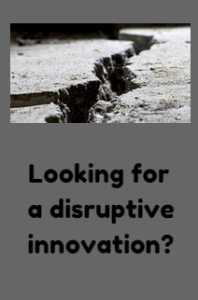Are you familiar with the concept of digital disruption? How about the ability to overcome digital disruption? These are scary times for many banking industry veterans. At least the ones in the know. This is especially true because of the banking industry digital disruption.
Make no mistake, if you don’t discover, you won’t invent, and if you don’t invent you will be disrupted. It’s just a matter of time. However, you can’t just show up one day and decide you want to work with the world’s greatest minds. Even Google, with all its resources and acumen, has had to work really hard at it.
It’s made these investments in time, focus and resources because it understands that the search business, as great as it is, won’t deliver outsized profits forever. Today, we no longer have the luxury to manage for stability, but must prepare for disruption.

Check out our thoughts on building innovation.
It is pardonable to be defeated, but never be surprised.
– Frederick the Great
Check this: Amazon and Managing Innovation … the Jeff Bezos Vision
The industry is going through “disruptive” change, a phenomenon that has transformed industries such as retailing, computing, airlines and automobiles. The bad news is that when the dust of digital disruption settles, historically even the best-run companies typically end up in the loser’s column.
Here is a story you will like. In 1960 two men made a bet. There was only $50 on the line, but millions of people would feel the impact of this little wager.
The first man, Bennett Cerf, was the founder of the publishing firm, Random House. The second man was named Theo Geisel, but you probably know him as Dr. Seuss. Cerf proposed the bet and challenged that Dr. Seuss would not be able to write an entertaining children’s book using only 50 different words.
Dr. Seuss took the bet and won. The result was a little book called Green Eggs and Ham. Since publication, Green Eggs and Ham has sold more than 200 million copies, making it the most popular of Seuss’s works and one of the best-selling children’s books in history.
At first glance, you might think this was a lucky fluke. A talented author plays a fun game with 50 words and ends up producing a hit. But there is actually more to this story and the lessons in it can help us become more creative and stick to better habits over the long-run.
In the computing industry, for example, Digital Equipment Corporation missed the personal computer (P.C.) in the early 1980s, started to fall apart in the early 1990s, and got acquired by Compaq in 1998.
We live in the age of digital disruption – a time when organizations are challenged to transform . . . or die. That’s not an overstatement in an era where household brands are both materializing and disappearing on a near-daily basis.
Technology is advancing at a mind-boggling pace, and innovative businesses are launching all the time, each raising the bar on consumer expectations just a tad higher.
The average business is massively challenged by the demand for near-constant transformation.
The forces of digital disruption are radically altering how we all access and consume information, communicate and socialize, shop and purchase.
Ubiquitously connected devices, social networks, cloud services – these and other innovations have already essentially inverted the relationship between sellers and buyers, between brands and customers.
Consumers are empowered by information and shared opinions, and they are emboldened by choice. They have developed an appetite for rich and rewarding interactions, and they rarely hesitate to seek alternatives when disappointed.
Increasingly, companies will succeed and fail according to the quality of the digital experiences that they offer.
We are indeed witnessing what can be best described as the end of business as usual. With the closure or dwindling performance of businesses once regarded as too big to fail or with the rise of every new Occupy-like movement around the world, we are reminded of the grand chasm that exists between consumer values and the values of today’s businesses.
What is becoming painfully obvious is that people everywhere are calling for change and they’re taking to the streets and also their smartphones, tablets, and popular social networks to demand attention.
The reality is that people are much more connected than ever before and their mission is to not only mind the gap but narrow it.
Technology is a game-changer and through the devices and networks that connect consumers, it is also the critical path for businesses to earn and re-earn relevance and trust.
Without evaluation or introspection, businesses, however, may well face digital Darwinism, the evolution of consumer behavior when society and technology evolve faster than the ability to adapt.
Back in 1993, a man named Gordy Thompson worked for the Times. His job title was “internet services manager,” and I’m sure the big bosses at his company had no idea who he was, or what that really meant.
What did he try (and fail) to tell them?
“When a 14-year-old kid can blow up your business in his spare time, not because he hates you but because he loves you, then you got a problem.”
Understand, Thompson was in the habit of hanging out on internet message boards.
And he had noticed that fans of the Miami Herald’s popular humor columnist Dave Barry were re-posting Barry’s columns online, so people who couldn’t read the Herald could enjoy them.
In other words, the greatest competitive threat for newspapers was… the popularity of their own content! People wanted more of it, and they wanted it instantly.
It’s the same thing that happened to the book industry with Amazon.com and now e-books on demand.
It’s the same thing that happened to the financial industry when consumers started trading stocks online instead of using traditional stockbrokers.
And to the record companies that once ruled the music industry with an iron fist.
The list goes on and on.
There is at least a little good news for the banking industry: lessons learned from past failures can help to ensure success in instilling needed change.
Even better, banks have real assets to bring to this fight, and a number of experiments with new products and business models could point the way towards future positive change.
This blog describes reasons why banking leaders can stumble in the face of disruption and describes a few recommendations to help them avoid those pitfalls.
Success won’t come easily, but by following these recommendations, banks have a chance to successfully navigate through increasingly turbulent times.
Three barriers typically make it difficult for banking leaders (just as in future industries) to get disruption right:
Fail to spot the disruptive change early enough
Disruptive change tends to start innocently at a market’s fringes. Market leaders tend to dismiss early disruptive developments because they just don’t affect their core business.
Fail to allocate sufficient resources towards disruptive offerings
Disruptive innovations often have lower performance and lower prices than established offerings.
Companies find it hard to prioritize spending time and money on disruption when they have seemingly attractive opportunities in their core business.
Force the disruptive initiative into the existing business model and product concept
Eastman Kodak Company spotted digital imaging in the 1970s. It invested billions of dollars to create its first commercial camera, a $30,000 camera targeting the professional market.
Only recently has it embraced simplicity and begun to experiment with new business models. Had Kodak made different choices and realized the potential to create new business models sooner, it could have owned digital imaging instead of being one of many players in space.

The challenges faced by the banks
The innovation challenge facing the banks is tough as they have inherited obsolete legacy systems and mindsets. Consider when 40-year old legacy banking systems meet the new iPhone 6 … the results aren’t pretty.
As one might expect, non-banks are moving in to meet the need. This includes IT giants like Google, Apple and PayPal, and traditional retailers like Wal-Mart.
Our study of the banking industry suggests that the second and third problems are more pressing. Most banks still focus a disproportionate share of time and attention on their traditional products.
While not ignoring those products, allocating more resources towards new products and business processes is essential. It seems clear to us that banking companies must reimagine their content and business models if they hope to succeed in the medium to long-term.
To maximize their chances of successfully prospering in the next generation, banking companies should remember the following principles:
Assume a market-first perspective
One of the core principles of succeeding with disruptive innovation relates to how to connect with customers. The concept is elegantly simple: people don’t buy products, they hire them to get jobs done in their lives.
When people encounter a problem, they look around for the solution that allows them to solve the problem.
Too often, companies define markets through their own internal lenses, missing great opportunities staring them in the face. Opportunities offered by their own customers.
To succeed, then, answer these questions: what are the tasks customers are seeking to get done in their lives? How could you improve your current products so they get the task done better than by using any other competitor?

The banking industry’s business model has stayed broadly consistent for years and its profit margins are a testament to its power.
Succeeding with disruption requires embracing new models. A difficult job compounded by the disasters over the last decade.
Here are some adaptive ideas banking companies should consider for new products and business models in the future:
Design all services online from mobile phones
For example, your phone will be learning of investment opportunities on an instantaneous and ongoing basis and present them to you.
Build services to revolve around customers’ choices
For instance, as you develop and start saving money, you will have the instant and personal choice to delegate your money management to a number of providers, or you can manage it yourself.
You will be able to set criteria that will update your portfolio with your preferences, for example, investing only in environmentally sustainable businesses.
Build super security into all products and service
This will be a difficult, expensive, and continuous process and probably never be done. It may require creating consortiums of banking partners to accomplish. But it is the foundation of the bank of the future.
Banks of the future will require less office infrastructure
As an example, consider Ally Bank. It operates two offices in the United States, one in Utah and one in Pennsylvania, and has 616 employees as of June 2009.
The bank has no branches and customers handle their banking affairs entirely online. Sets the correct example, considering the cost savings, doesn’t it?
Banks will be replaced by platforms
Some of these banks are already at work of this, such as Ally Bank discussed above.
These platforms are run almost entirely by algorithms and robots – they will essentially become technology companies that mediate information and analysis about customers, products, and markets.
Bottom line takeaways
What will be the outcome of this frenzy of innovation activity in the banking sector? Only time will tell. In any sector, market-creating innovation is a difficult business, with many failures for every success.
It is a safe prediction that some banks won’t make the transition to the emerging customer-oriented digital world.
A key determinant of success will be changing management mindsets.
